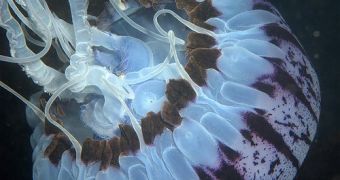An international team of scientists, along with the Balearic Oceanography Center of the Spanish Institute of Oceanography (IEO), have carried out a study over a period of 50 years, and confirmed the increase in size and intensity of proliferations of the purple stripped jellyfish, Pelagia noctiluca.
They studied the rise in the frequency of this group of cnidaria in the North Sea from 1958 to 2007 – fifty years that cover the global warming in the hydro-climatic regime, observed since 1980, through molecular methods.
María Luz Fernández de Puelles, the only Spanish co-author of the study, and a researcher at the IEO's Balearic Oceanography Center, told SINC that “the records for the Mediterranean are much more recent and not as long or continuous, but they further strengthen the study.”
Even though adult Pelagia noctiluca have been recorded in several parts of the western Mediterranean, including the Balearic Islands, their numbers were striking in the autumn and winter of 2007, as well as in the spring of 2010 and in the summers as too.
After analyzing the available data for the Mediterranean, the researchers concluded that there is a 12-year proliferation cycle of these jellyfishes, with most of them lasting for four years.
“"However,” explains Fernández de Puelles, “since 1998 these periods have become shorter and more frequent,” and there seem to be several reasons for this, including over-fishing and the current rise in sea water temperatures.
“Since 2002,” she added, “these organisms have become increasingly frequently found in the north east Atlantic in winter, since winters have been warmer, and they have tended to appear earlier and spend more time in their annual cycle there.”
Warmer winters are responsible for the entry of the surface current into the Mediterranean Sea past Gibraltar, which creates perfect conditions for the jellyfish Pelagia noctiluca, a species that thrives along Spanish coasts, since there are more food resources here than in oceanic areas.
“We have shown that they can reproduce rapidly if the conditions are right, and can reach large densities throughout the whole year, particularly if winters are warm”, the scientist explains.
Pelagia noctiluca is a jellyfish belonging to the class of the Scyphozoa, that has a very complex and long life cycle.
It lives in the warm waters of the Atlantic and the Mediterranean, usually in the areas of the ocean closest to the surface, still at a certain depth, which makes it hard to observe.
This intriguing animal can form vast blooms, visible from the costs and beaches of Spain, AlphaGalileo reports.
Fernández de Puelles explains that “jellyfish are very voracious predators at the top of the trophic network.
“They feed directly on fish larvae and compete with other zooplankton organisms for food, meaning that they drastically alter the trophic structure of marine ecosystems.
“"Further studies should be carried out into the impact of this,” the marine biologist concludes.
The rise in the populations of jellyfish over the years, affects fisheries, fish farming and tourism “because of the jellyfishes' toxic effects and the poison in their tentacles, and because they appear particularly in the summer, having a significant socioeconomic impact”, Fernández de Puelles adds.
This research has been published in the Journal Biology Letters.

 14 DAY TRIAL //
14 DAY TRIAL //